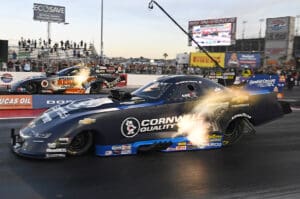
Ted Jones knows a thing or two about survival.
In 1989, the former drag racing executive had to call on every instinct he possessed to keep the IHRA afloat.
The IHRA of ’89, when compared to the 2009 version, bears a striking resemblance. There’s no series sponsor, and the only semblance of a points fund are a few special shootout programs. In both cases, a modest sportsman championship fund is the foundation from which to build.
A sportsman fund, an office, and a field full of dedicated IHRA staffers determined to churn their way through a tough season.
Last season, the IHRA ran into a combination of perfect storms related to the series being sold, open racer revolts, and a series sponsor who defaulted on millions of dollars worth of sponsorship monies.
The IHRA, for the first time since 1989, entered a season (2009) without a professional championship point fund.

“I would give the 2009 season more hope than I would have 1989 because of the Feld family,” Jones said of the new IHRA owners. “They [Feld] are a professional organization in every sense of the word. They have their ducks in a row.”
If Jones had the backing of the Feld Family in 1989, things might have been a bit easier.
No disrespect intended towards Jim Ruth, who saved the IHRA from going totally out of business when he purchased the sanctioning body from Billy Meyer; the new owner just didn’t have the same kind of entertainment infrastructure to draw upon.
In 1989, there was no structure.
Gone were the sponsors, gone were the employees, and totally gone was the morale of the sanctioning body.
Billy Meyer had called Jones to discuss the possibility of selling the IHRA to either him or a group of investors. Jones had the idea that selling the IHRA to a group of IHRA national event track owners would have been a neat concept.
There was only one problem with the idea. No one was willing to buy into the program except Jim Ruth, who was a Pro Stock racer and owner of Bristol Dragway.
“The IHRA had, for all intents and purposes, been shut down,” Jones said. “Billy [Meyer] had laid everyone off. The track operators had no idea what was going to happen.”
Talk about a last-minute program; Jones was given the task of resurrecting the once mighty proud alternative sanctioning body with only three weeks before the season-opener in Darlington, S.C.
“That’s when we had all of the paperwork signed,” Jones added, recalling the details of Jim Ruth’s purchase of the series.
“We couldn’t do anything until we actually owned the sanctioning body.”
Jones was a master of the last minute, but even this challenge seemed overwhelming.

Where does a man start when he tries to make chicken salad from chicken poop?
The national schedule was the starting point, followed by a regional schedule. The regional schedule served as the “points” races before the IHRA adopted the divisional format in 2000.
Then, he printed a rulebook and distributed it to the racers.
Then there was the issue of the house publication Drag Review, which had been relocated to Waco, Texas, and had to be moved back to the IHRA’s headquarters in Bristol, Tenn.
An average person could have been easily overwhelmed, but for Jones, he had no choice. It was sink or swim.
“Fortunately I was able to reassemble most of the staff who were with the IHRA when Billy bought it,” Jones said. “Many hadn’t taken jobs even though they were laid off. That really helped.”
That was the one thing that made the most difference for Jones.
“They knew what to do,” Jones added. “It was like putting a car into drive. If it hadn’t have been for that experienced staff it would have been next to near impossible.
“We put in some long days.”

The end result of the long days was something the overworked staff could appreciate, but to the outside world, the finished product had a face only a mother could love.
The point funds and bonus races were piecemeal but provided enough of a ray of hope to keep the racers and fans interested.
The May 15, 1989 issue of Drag Review announced the various bonus points programs. There was the Angus Nitro Showdown, which awarded $20,000 to the Top Fuel winner, while Coogle Industries picked up the $6,500 bonus for the Alcohol Funny Cars. The Nitro Funny Cars had no shootout.
The sportsman divisions featured backing from Ram Automotive, Weld Racing, and Lonestar Racing. However, when one figured in the title rights backing from local Bristol companies supporting programs such as the Wholesale Jewelry Great Class Comeback (Modified), Apollo Oil Shootout (Super Stock), and Tri-City Liquors (Stock), one could either laugh or become inspired.
More were inspired than amused.
“We sold sponsorships anywhere we could and to anybody,” Jones admitted. “But that’s what you have to expect when you begin working on the season in February. When we took over the sanctioning body, there was nothing. No sponsorships, only the rights to the sanctioning body and the contracts for the events.”
Beyond that experience, Jones admits there was a lot more behind-the-scenes mending that he is legally unable to discuss because part of the buy/sell agreement included a disparage clause, which dictated that the new owners were unable to speak negatively against the former ownership.
“There was a lot of stuff that went on that I can’t talk about,” Jones added. “It happened, we made it through and we survived.”
Jones said the team at IHRA survived through the will of a dedicated group.
“I think when we saw the sponsors come back and the contingency companies returned, that’s when we knew we had survived,” Jones admitted. “When we had the first race, and the racers showed up, that was another good sign.
“I think that year proved my point that as long as somebody wanted the IHRA around, it would be there.”
Like in 1989, as long as sponsors, racers, and fans want the IHRA around, it will survive the struggles of 2009.











































